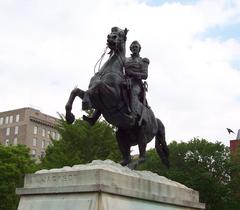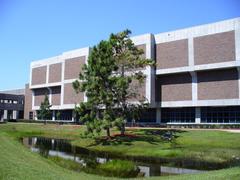
Timucuan Ecological And Historic Preserve
Timucuan Ecological and Historic Preserve: Visiting Hours, Tickets, and Expert Guide to Jacksonville’s Historical Sites
Date: 03/07/2025
Introduction
The Timucuan Ecological and Historic Preserve, situated where the St. Johns River meets the Atlantic coast in Jacksonville, Florida, stands as a testament to over 6,000 years of human history and extraordinary ecological diversity (NPS.gov). Spanning approximately 46,000 acres, it is one of the largest urban park systems in the U.S., blending salt marshes, dunes, hardwood hammocks, and vital historical landmarks. Visitors can immerse themselves in the preserved stories of the region’s indigenous Timucua peoples, European colonists, and African American communities, all while enjoying some of the most scenic natural landscapes in Florida (NPS History; LinkedIn Overview).
This guide delivers a detailed look at the Timucuan Preserve, including its history, main attractions, visitor amenities, accessibility, and essential travel tips. Whether you’re a history buff, a nature enthusiast, or a family seeking outdoor adventure, the preserve offers a unique and enriching experience.
Historical Overview
Indigenous Presence and Prehistoric Origins
For more than 6,000 years, the Timucuan Preserve has been home to successive Native American cultures. Archaeological finds—shell middens, pottery shards, and ancient tools—reveal how the earliest inhabitants adapted to the region’s estuarine and coastal environments (Birds and Wetlands). By the 16th century, the Timucua people had established fortified villages, developed agriculture, and built complex societies (NPS Articles).
European Contact and Colonial Rivalry
French explorer Jean Ribault arrived in 1562, claiming the land for France and setting the stage for rivalries that would reshape the region. The French constructed Fort Caroline in 1564, but were soon overpowered by Spanish forces under Pedro Menéndez de Avilés in 1565. The Spanish established missions and sought to convert and control the Timucua, whose population declined rapidly due to disease and conflict (Legends of America).
Plantation Era and African American Heritage
Following U.S. acquisition of Florida, plantation agriculture flourished. The Kingsley Plantation, founded by Zephaniah Kingsley and his wife Anna (a former slave from West Africa), stands as a powerful symbol of the region’s complex history of slavery, race, and resilience (NPS Kingsley Plantation). The tabby slave cabins and interpretive programs highlight the African American and Gullah Geechee heritage of the area (LolaApp).
Segregation, Modern Recreation, and Conservation
In the 20th century, American Beach became a haven for African Americans during segregation, while the Ribault Club attracted wealthy vacationers. As Jacksonville’s urban footprint grew, conservationists rallied to protect the remaining wild and historic lands. In 1988, Congress established the Timucuan Ecological and Historic Preserve, managed collaboratively by federal, state, and local agencies (Park Ranger John). Today, the preserve safeguards over 200 archaeological sites and diverse ecosystems.
Visiting Timucuan: Hours, Tickets, and Visitor Information
Hours and Admission
- General Preserve Hours: Open daily from sunrise to sunset.
- Visitor Centers (Fort Caroline & Kingsley Plantation): 9:00 a.m. to 4:30 p.m., Wednesday–Sunday. Closed Monday, Tuesday, and major holidays.
- Grounds: Most sites close at 5:00 p.m., but trails and natural areas like Spanish Pond and Theodore Roosevelt Area are open sunrise to sunset.
- Admission: Entry to all NPS-managed sites is free. Some special tours may require tickets or reservations (NPS Timucuan site).
Accessibility and Facilities
- Trails: Mixture of boardwalks, paved, and natural-surface trails. Some are wheelchair-accessible; contact the visitor center for recommendations.
- Restrooms & Water: Available at main visitor centers and select trailheads. Bring your own water for longer hikes.
- Pet Policy: Leashed dogs (max 6 feet) are allowed on trails and grounds but not inside buildings. Waste disposal is required.
Getting Around
- Transportation: A car is recommended—sites are spread across both sides of the St. Johns River. Public transportation is limited.
- Parking: Available at major sites, but may fill on weekends.
- No internal shuttle service. Rideshare apps operate in the city but not reliably at remote trailheads.
Main Attractions and Activities
Fort Caroline National Memorial
Commemorates the 16th-century French colony and struggle for control over Florida. Features reconstructed fortifications, exhibits, and ranger-led talks on indigenous and colonial history (NPS Foundation Document).
Kingsley Plantation
Florida’s oldest standing plantation house, with tabby slave cabins and interpretive trails. Guided tours delve into the lives of Zephaniah and Anna Kingsley, plantation operations, and the legacy of slavery (NPS Foundation Document).
Theodore Roosevelt Area
A 600-acre preserve of maritime forests, salt marshes, and hiking trails. Interpretive signs highlight wildlife, ecosystems, and Old Florida landscapes (NPS Foundation Document).
American Beach
Historic Atlantic beach founded for African Americans during segregation. Features the American Beach Museum and access to natural dunes and shoreline (NPS Foundation Document).
Archaeological Sites
Over 200 sites reveal Native American, colonial, and plantation histories. Some are accessible via ranger-led tours; most are protected for preservation (NPS Foundation Document).
Salt Marshes and Estuarine Ecosystems
Among the largest remaining on the Southeast Coast, these habitats support abundant fish, birds, and aquatic life. Boardwalks and observation platforms offer prime wildlife viewing (NPCA.org).
Hiking, Boating, and Wildlife Observation
- Hiking: Notable trails include Willie Browne and Spanish Pond, with scenic overlooks and educational signage (NPS Things to Do).
- Boating/Kayaking: Launch points and guided tours offer water-based exploration.
- Fishing: Permitted in designated areas with state license.
- Birdwatching: Over 200 bird species, including waders, raptors, and songbirds.
Educational & Interpretive Programs
- Ranger-led walks, living history events, and school programs cover topics from indigenous lifeways to salt marsh ecology.
- Self-guided audio tours available via the NPS app.
Family Activities & Picnicking
- Picnic areas are near Fort Caroline and Theodore Roosevelt Area.
- Interpretive play areas and Junior Ranger activities for kids.
Ecological Significance
The Timucuan Preserve is a living laboratory—its salt marshes, maritime forests, and wetlands serve as nurseries for fish, filter pollutants, buffer storm surges, and support rare wildlife like the eastern indigo snake and red-cockaded woodpecker (Boat Bliss Blog). Conservation efforts focus on habitat restoration, invasive species removal, and community engagement.
Travel Tips and Nearby Attractions
- Best Seasons: Spring and fall for mild weather and wildlife activity.
- What to Bring: Water, snacks, sun and insect protection, binoculars, and camera.
- Nearby: Jacksonville Zoo, Cummer Museum of Art, historic neighborhoods, and local beaches.
- Lodging: No onsite accommodations. Jacksonville offers hotels and vacation rentals nearby.
- Safety: Stay on marked trails, respect wildlife, and check weather before visiting.
Frequently Asked Questions (FAQ)
Q: What are the Timucuan Preserve visiting hours?
A: Visitor centers are open 9:00 a.m.–4:30 p.m. Wednesday–Sunday. Grounds typically close at 5:00 p.m.; some areas are open sunrise to sunset.
Q: Do I need tickets or pay entrance fees?
A: No, NPS-managed sites are free. Some non-NPS areas may charge fees; check ahead.
Q: Are guided tours available?
A: Yes, ranger-led and self-guided tours are offered. Group tours can be requested via email.
Q: Can I bring my dog?
A: Yes, leashed dogs (6 feet max) are welcome on trails and grounds. Service animals only inside buildings.
Q: Is the preserve accessible?
A: Some trails and facilities are accessible. Contact visitor centers for recommendations.
Plan Your Visit and Stay Connected
For the latest updates, events, and maps, visit the official NPS website and download the NPS app.
Follow the preserve’s social media channels for news, alerts, and educational content.
To enhance your experience, download the Audiala app for interactive maps, guided audio tours, and real-time updates. Explore related posts on Jacksonville historical sites and Florida natural preserves, and share your adventure with our online community.
References
- Timucuan Ecological and Historic Preserve, National Park Service
- Exploring the Timucuan Ecological and Historic Preserve, Birds and Wetlands
- Timucuan History and Archaeological Overview, NPS History
- Timucuan Ecological and Historical Preserve Overview, LinkedIn
- Timucuan Articles on Indigenous and Colonial History, NPS Articles
- Legends of America: Timucuan History
- Timucuan Ecological and Historical Preserve, LolaApp
- Florida Visiting: Timucuan Preserve
- Timucuan Kingsley Plantation, NPS
- Timucuan Ecological and Historical Preserve, Park Ranger John
- Timucuan Preserve Ecological Significance, NPCA
- Timucuan Preserve Visitor Information, NPS
- Timucuan Foundation Documents and Visitor Guide, NPS History
- Timucuan Preserve Things to Do, NPS
- Boat Bliss Blog: Timucuan Ecological and Historical Preserve
- Trip Memos: Timucuan Ecological and Historic Preserve





















































